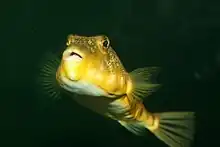Northern puffer
The northern puffer, Sphoeroides maculatus, is a species in the family Tetraodontidae, or pufferfishes, found along the Atlantic coast of North America.[2] Unlike many other pufferfish species, the flesh of the northern puffer is not poisonous, although its viscera can contain poison,[1][2] and high concentrations of toxins have been observed in the skin of Floridian populations.[3]: 30 They are commonly called sugar toads in the Chesapeake Bay region, where they are eaten as a delicacy.[4] There was widespread consumption of northern puffers during the rationing that accompanied the Second World War, establishing a commercial fishery that reached its zenith in the 1960s.[1][3]: 36–39 In much of the Northeast, the fish is known simply as "blowfish" or "chicken of the sea".[5] They may also be sold as "sea squab".[1][6]
| Northern puffer | |
|---|---|
 | |
| Scientific classification | |
| Domain: | Eukaryota |
| Kingdom: | Animalia |
| Phylum: | Chordata |
| Class: | Actinopterygii |
| Order: | Tetraodontiformes |
| Family: | Tetraodontidae |
| Genus: | Sphoeroides |
| Species: | S. maculatus |
| Binomial name | |
| Sphoeroides maculatus (Bloch & J. G. Schneider, 1801) | |
Description
The northern puffer has the shape of a club.[6] Adults have small spines covering the entire body with a tiny beak-like mouth. It is characterized by vertical stripes with a gray to brown dorsal surface and a yellow to white belly.[6] It has tiny jet-black pepper spots (about 1 mm in diameter) scattered over most of pigmented surface, particularly evident on cheeks. Lower sides of the body have a row of black, elongate, bar-like markings. A small dorsal fin is set far back near the tail. Sphoeroides maculatus, like others in the puffer family, "puffs up" into a ball in self-defense by inhaling water into a special chamber near its stomach. They will puff up with air if taken out of the water. The northern puffer reaches up to 36 cm (1 ft 2 in) in length, but is usually around 20 cm (8 in).[2]
Habitat
The northern puffer inhabits bays, estuaries and protected coastal waters at depths of 10–183 m (33–600 ft) in the northwest Atlantic.[2] It ranges from Florida (U.S.) to Newfoundland (Canada).[2]
Diet
The northern puffer feeds primarily on shellfish, and occasionally on finfish. Using its beak-like mouth it can extract shellfish from their shells and sometimes break the shells to obtain a meal. They will attack blue crabs, blowing water underneath to turn the crab over, then attack the underside before it can right itself.
Life cycle
Northern puffers spawn from May through August in shallow water over sandy or muddy bottoms. The adhesive eggs are defended by the male until they hatch.[6]
References
- Shao, K.; Liu, M.; Hardy, G.; Jing, L.; Leis, J.L. & Matsuura, K. (2014). "Sphoeroides maculatus". The IUCN Red List of Threatened Species. IUCN. 2014: e.T190246A1945870. doi:10.2305/IUCN.UK.2014-3.RLTS.T190246A1945870.en. Retrieved 15 January 2018.
- Froese, Rainer; Pauly, Daniel (eds.) (2008). "Sphoeroides maculatus" in FishBase. June 2008 version.
- Sibunka, John D.; Pacheco, Anthony L. (February 1981). "Biological and Fisheries Data on northern puffer, Sphoeroides maculates (Bloch and Schneider)". Highlands, New Jersey: Sandy Hook Laboratory, Northeast Fisheries Center, National Marine Fisheries Service. Technical Series Report No 26. Retrieved 29 July 2023 – via NOAA Institutional Repository.
- McClane, A.J. (1977). The Encyclopedia of Fish Cookery. Photographs by Arie de Zanger. Holt, Rinehart and Winston. p. 249. ISBN 9780030154317.
- Misak, Bob (17 June 2014). "Chicken of the Sea". On the Water. Retrieved 29 July 2023.
- "Northern Puffer". Chesapeake Bay Program Bay Field Guide. Archived from the original on 27 September 2011.
